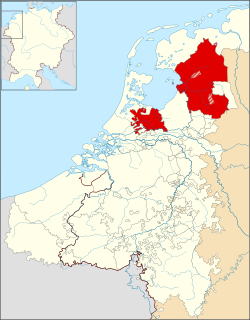Bishopric of Utrecht
| Bishopric of Utrecht | ||||||||||
|
Sticht Utrecht (nl) Hochstift Utrecht (de) Principauté d'Utrecht (fr) |
||||||||||
| State of the Holy Roman Empire | ||||||||||
|
||||||||||
|
||||||||||
|
Bishopric of Utrecht c. 1350. Nedersticht is the smaller territory while Oversticht is the larger territory.
|
||||||||||
| Capital | Utrecht | |||||||||
| Languages | Middle Dutch, Middle Low German | |||||||||
| Religion | Catholic | |||||||||
| Government | Principality | |||||||||
| Prince-bishop | ||||||||||
| • | (1024–1026) | Adalbold II of Utrecht | ||||||||
| • | (1524–1528) | Henry of the Palatinate | ||||||||
| Historical era | Middle Ages | |||||||||
| • | Lower Lotharingia divided from Lotharingia | 959 | ||||||||
| • | Established | 1024 | ||||||||
| • | Investiture Controversy | 1075–1122 | ||||||||
| • | Concordat of Worms | 1122 | ||||||||
| • | Guelders Wars | 1502–1543 | ||||||||
| • | Disestablished | 1528 | ||||||||
| • | Union of Utrecht signed | 1579 | ||||||||
|
||||||||||
| Today part of |
|
|||||||||
The Bishopric of Utrecht (1024–1528) was a civil principality of the Holy Roman Empire in the Low Countries, in present Netherlands, which was ruled by the bishops of Utrecht as princes of the Holy Roman Empire.
From 1024 until 1528, it was one of the Prince-Bishoprics of the Holy Roman Empire, constituting, in addition to its ecclesiastical aspect, a civil state within the Empire. In 1528, Charles V, Holy Roman Emperor, secularized its civil authority and territorial possessions.
The Diocese of Utrecht was established in 695 when Saint Willibrord was consecrated bishop of the Frisians at Rome by Pope Sergius I. With the consent of the Frankish ruler, Pippin of Herstal, he settled in an old Roman fort in Utrecht. After Willibrord's death the diocese suffered greatly from the incursions of the Frisians, and later on of the Vikings. Whether Willibrord could be called the first bishop of Utrecht is doubtful; as James Palmer points out, "there was no real concept of a well-defined bishopric until at least the days of Alberic (775–84)". And while Saint Boniface is referred to in his hagiographies as the successor of Willibrord (and, in turn, Gregory of Utrecht is referred to as the successor to Willibrord and Boniface), this does not necessarily mean "successor as bishop", but rather that they succeeded each other as missionaries to the Frisians.
Better times appeared during the reign of the Saxon emperors, who frequently summoned the Bishops of Utrecht to attend the imperial councils and diets. In 1024 the bishops were made Princes of the Holy Roman Empire and the new Prince-Bishopric of Utrecht was formed. The secular territory over which it ruled was known as Sticht Utrecht or Het Sticht (a sticht was any piece of land governed by a bishop or abbot). This territory was divided into the Nedersticht (Lower Sticht, roughly corresponding to the present day province of Utrecht) and Oversticht (Upper Sticht, encompassing the present-day provinces of Overijssel, Drenthe, and part of Groningen).
...
Wikipedia



